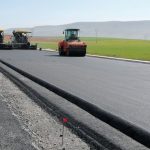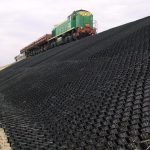Motor vehicle traffic and its accompanying pollution have been a major environmental concern for decades. With approximately1.2 billion vehicles in operation today and more on the way, Earth’s atmosphere continues to absorb massive amounts of harmful emissions from a billion internal combustion engines on a daily basis. However, the problems don’t end with emissions. Roads and parking lots have greatly expanded to accommodate the growing number of vehicles, creating another series of problems. The materials used, primarily asphalt and concrete, negatively impact the environment in three ways.
1. They Deplete resources.
Asphalt is a petroleum-based product. Concrete requires rock, sand and a fabricated cement component to strengthen the material and hold the pavement together. Drilling, mining, processing and applying these materials to the roadway are resource-intensive processes. Fortunately, industry innovation has led to meaningful progress toward resource conservation. Road construction companies have developed ways to reuse existing concrete and asphalt by remixing it with virgin materials. While this reduces resource depletion, producing asphalt and concrete still uses a considerable amount of energy.
2. They Pollute water.

Road and parking lot projects usually require elaborate drainage networks to remove rainwater from the surfaces and prevent flooding. Flowing over pavement exposes water to pollutants surface debris and asphalt. This polluted water eventually flows municipal sewage networks, which empties into lakes, rivers, and streams.
3. They Generate Harmful Atmospheric Emissions.
Petroleum-based asphalt is a high-VOC (volatile organic compound) substance. As the product is converted to asphalt, significant quantities of harmful gases are released into the atmosphere. Likewise, the process of producing cement for concrete requires high levels of heat and generates substantial VOC emissions. The application and curing of the applied asphalt add even more harmful material to the air. Additionally, some areas still use high-VOC paints for striping roads and parking lots, adding another unsustainable element to the process of road and parking lot construction.


